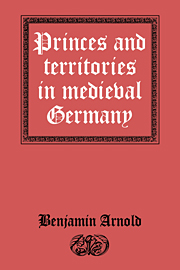Book contents
- Frontmatter
- Contents
- Acknowledgements
- List of abbreviations
- Introduction
- PART I CROWN AND PRINCE
- PART II PRINCELY TITLE AND OFFICE
- PART III DYNASTIES, PRELATES, AND TERRITORIAL DOMINION
- 8 From consanguinity to dynasty?
- 9 Material foundations: colonization, forest, towns, and communications
- 10 The reform of regional jurisdictions in the twelfth and thirteenth centuries
- 11 The anatomy and nomenclature of princely dominion, 1150–1330
- 12 Feuds, inheritance, and partition
- 13 Region and territory: effects and outcome
- Conclusion
- Index
11 - The anatomy and nomenclature of princely dominion, 1150–1330
Published online by Cambridge University Press: 03 December 2009
- Frontmatter
- Contents
- Acknowledgements
- List of abbreviations
- Introduction
- PART I CROWN AND PRINCE
- PART II PRINCELY TITLE AND OFFICE
- PART III DYNASTIES, PRELATES, AND TERRITORIAL DOMINION
- 8 From consanguinity to dynasty?
- 9 Material foundations: colonization, forest, towns, and communications
- 10 The reform of regional jurisdictions in the twelfth and thirteenth centuries
- 11 The anatomy and nomenclature of princely dominion, 1150–1330
- 12 Feuds, inheritance, and partition
- 13 Region and territory: effects and outcome
- Conclusion
- Index
Summary
The growing familiarity of new vernacular compounds, lantgerihte for comital jurisdiction and landesherren for the nobility, as well as lantfrede and lantgrâve, does suggest a refashioned preoccupation with lands and a more apparent territorial dimension to princely authority. Nevertheless, the terminology of local rule was not modernized in the thirteenth century, because aristocratic family rights of property or tenure under Lehnrecht had not yet given way to abstract principles of government over places and classes with their consent as Estates or Landstände under the prince. If anything, the transition from consanguinity to dynasty in full swing by 1100 served to strengthen the patrimonial attitude whereby lordship over the land, and its disposal or partition as family property, was above all a legally inherited princely right under the distant suzerainty of the emperor as dominus imperii, lord of the Empire. The mental and legal apparatus for a type of ‘princely’ sovereignty may already have been apparent in the rights of the seven electoral princes as outlined in the ‘Golden Bull’ of 1356, but for most princes this did not become a possibility before the administrative and legal reforms of the fifteenth and sixteenth centuries associated with the reception of Roman Law at a local level.
In the thirteenth century the princes did not consciously desire to confine the language and practices of lordship behind frontiers or boundaries actually drawn across the land, quite in contrast to classical or modern notions.
- Type
- Chapter
- Information
- Princes and Territories in Medieval Germany , pp. 211 - 233Publisher: Cambridge University PressPrint publication year: 1991



